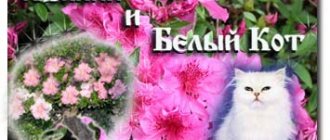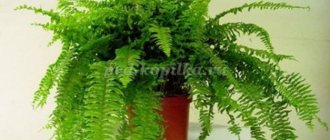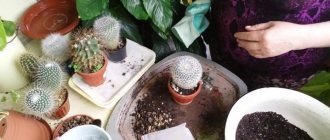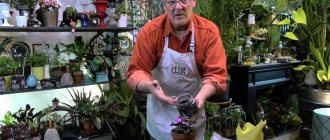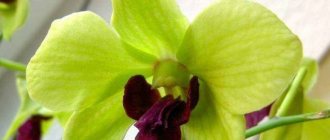GCD "Indoor plants" (middle group)
Well done! Guys, you already know that every plant has its own name. What names of indoor plants do you know? (Children name the plants and show them.)
2. Didactic game:
“Indoor and garden plants”
Educator:
Guys, what plants do you know besides indoor plants? (garden)
Can you tell them apart? On the table you see cards with pictures of indoor plants and garden flowers. They need to be distributed as follows: place indoor plants next to the flower pot, garden flowers - next to the flower bed.
3.Conversation about indoor plants:
Educator:
Children, look how many indoor plants there are in our group. What do you think these plants are for? (To make it beautiful.)
What else are indoor plants used for?
(Plants purify the air.)
It’s right that it should be beautiful—a person decorates his home with indoor plants. But they not only delight us with their beauty, but also cleanse the air of dust and dirt. Many indoor plants smell good.
Guys, what should you do to ensure that your indoor plant is always beautiful and doesn’t wilt? (care for a houseplant)
Let's tell you how we care for plants.
( children's answers)
4. Physical education:
Eat at home ( stand on your toes, stretch your arms up);
And there are bridges ( lean forward, arms back, knees straight
);
There are trees straighten up, ( round your arms above your head)
;
And the bushes, ( sit down, stretch your arms forward)
;
And to everyone’s surprise ( stand up, arms to the sides, body turns)
,
Plants in the room ( shoulders raised)
;
We can’t live without them ( hands on the belt, turning the head to the right and left)
;
Because we are friends! ( spread your arms to the sides, clasp your body with your arms
).
5. Game:
"What would happen if..."
-What would happen if the plant was placed in a dark place?
— What would happen if they forgot to water the plant?
— What would happen if you take care of the plant: water it, wash it, loosen the soil, feed it?
(Children's answers)
.
6.Planting a plant
Educator:
Let's plant geraniums with you. What does it take to plant a plant? (flower pot, soil, water for irrigation)
.
Children participate in planting the plant.
Educator:
Take a flower pot. What should we put in the pot first? (We fill the flower pot with soil and make a hole for the flower.)
After we've poured the soil, what's next?
(We plant the flower in the ground and sprinkle it.)
We have planted the plant, is there anything else that needs to be done? (Immediately after planting, the plant needs to be watered so that it grows better).
Reflection:
Complete the sentence: “I love taking care of indoor plants,
because..." (
children's answers)
Teacher:
Project in the middle group on the topic: “Houseplants are our friends”
Transcript
1 BDOU in Omsk “Kindergarten 247 combined type” Project in the middle group on the topic: “Indoor plants are our friends” Authors: Senetskaya A.V. Valitova R.T. Omsk 2014
2 Project type: research, short-term (2 weeks), group. Project participants: children, teachers, parents. Relevance: In our age of technical education, the problem of reducing cognitive interest, love and respect for living nature has become acute. Adults, and especially children, looking at their parents, are completely immersed in the virtual life of computers and other gadgets. In the conditions of city life, we have completely stopped noticing the beauty, kindness and gifts of the nature around us. Children now, from a very early age, are beginning to have a remarkable understanding of phones, computers and other consoles; they have completely taken over their sphere of interests. The world around them no longer arouses such interest in them as before. Our group conducted a survey among children and their parents, which revealed that most 4-5 year old children do not know whether they have indoor plants at home, they simply do not notice them, children do not know why indoor plants are needed, they do not know how to care for them and are not interested in them. The children have insufficiently developed labor skills and abilities to care for indoor plants, and lack knowledge about indoor plants. But it is so important to form in the younger generation a sense of beauty, responsibility for someone or something, teach them to work and enjoy it. Expected results: 1. Expansion of knowledge on environmental culture of students. 2. Development in children of a sustainable interest in representatives of the plant world and indoor flowers. 3. Development of research activities of preschoolers in the course of joint practical activities. Educational areas: artistic-aesthetic, communicative-personal, cognitive-speech development. Purpose: Educational: to help expand children's knowledge about indoor plants and their significance; develop practical skills in caring for indoor plants.
3 Educational: fostering a love of nature, observation and respect for plants; promote the development of environmental culture. Material: Improving the ecological environment in the group, combining the efforts of the teacher, children, parents aimed at improving and greening the group. Objectives: 1. Increase the level of environmental culture and knowledge on the topic “Houseplants”. 2. Involve parents in this problem. 3. Learn to compare plants, find similarities and differences in external characteristics (indoor plants and plants growing outside). 4. Develop interest in the development and growth of plants, curiosity and observation. 5. Develop skills and abilities to care for indoor plants. Material: slides or photographs “Room without indoor plants”, “Room with indoor plants”; indoor plants, a scoop, watering cans with water, wooden sticks for loosening; dust removal wipes; game (cards) “What do plants need to grow”; “Find a plant by name”, “Unusual flowers”. STAGES OF PROJECT IMPLEMENTATION: Stage 1. Preparatory Collection of information on the topic “Indoor flowers”; making cards for games; selection of illustrations; production of a passport for indoor plants; preparing conversations with children; development of notes for nodes. Involvement of parents: communication about the project, request to help children find information. Stage 2. Main Work with parents - helping children find information about indoor plants in the house; -photo of a child with an indoor flower; - writing a story about your (home) indoor flower;
4 Conversations with children: Educational conversations: “The history of houseplants”, “Are houseplants friends or enemies?”; “Structure of a houseplant”; “Plants in our lives”; “Help the plants”; “Tell Dunno about indoor plants”; "Care for indoor plants." Conversations discussion: “What do plants need to live?”; “How to water indoor plants?”; “How do children and their parents take care of indoor plants?”; “On what occasions are flowers given?” Solving problem situations: “If you don’t water the flowers for a long time, the leaves fade and the flowers fall”; “If a flower is left without light, in the dark, what will happen?”; “Can a plant breathe?” Cognitive activity: GCD: “Houseplants are our friends”; "Flowering Plants"; “I’m learning to care for a houseplant,” “Our new green friend.” Game activity: Didactic games: “What has changed?”, “Nai di the same”, “Guess the plant by description”, “Describe, I will guess”, “What is missing?”, “Nai di plant by name”, “What first, what then?”, “Unusual flowers”, “Flower shop”. Role-playing games: “Florist”; "Birthday"; "Flower shop"; "Family". Communication: Learning and reading a poem about plants; reading popular science and fiction literature on the topic; discussion of proverbs, sayings, guessing riddles; looking at illustrations, postcards depicting indoor plants. writing descriptive stories. Music: Development of positive emotions; listening to the musical work “P.I. Chai kovsky": "Waltz of the Flowers" and "Seasons".
5 Outdoor games: “Collect a flower from petals”; “Deck the carpet with flowers”, “Gardener”. Breathing exercises: “Let’s blow on a flower,” “Let’s warm the flower with our breath.” Labor: Work in a “nature corner” to care for indoor plants. Artistic creativity: Drawing on the theme “Indoor Flowers”, coloring coloring books on the topic, drawing “Violet in a Pot”, modeling “Beautiful Flower”, plasticine painting “Indoor Flower”, drawing with paints, pencils, crayons on indoor plants, applique “Cactus”, collective work in mixed media “I love the flowers in the room, just as you love them.” Excursions to corners of nature in other groups, around the kindergarten. Replenishment of the development environment: - replenishment of the corner of nature with the necessary equipment (watering cans, rags, basins and buckets, aprons); equipping the ecological zone in the group with new plants; production of a “Passport for indoor plants”; a series of experiments to identify the needs of plants for moisture, heat, light; cards for caring for a houseplant; illustrations; card index of didactic games for getting to know indoor plants. -Photo report (slide film) -Screen folders on the topic. -Exhibition of works stage 3. Final
SAMPLE SUMMARY OF CLASSES ON INDOOR PLANTS IN A MIDDLE GROUP
OUR NEW GREEN FRIEND
(with FEMP elements)
GOAL: To introduce children to a new plant - Impatiens. Give its everyday names (Ogonyok, Vanka wet). Teach children to describe a plant, noting its characteristic features. Learn to look at a plant in a certain sequence, work with sensory standards and graphic models. Develop speech. Strengthen counting and knowledge of geometric shapes. Develop an interest and caring attitude towards indoor plants.
MATERIAL: Photo of a new indoor plant and a note, indoor plants outside the group. Sensory standards of surface (smooth, velvety), shapes (oval, circle, triangle), edges of sheets (flat, not smooth), color standards (pink, red)
PROCEDURE: Before class, the teacher quietly places an envelope with a photo of a new plant and a note under a pot with any flower. Offers to visit one of his green friends. Names a plant familiar to the children, the children find it. Under it is an envelope - a letter from Thumbelina, in which she says that she is giving a new flower (name in the photo). Offers to find a flower outside the group (in the foyer, locker room, where there are others besides this flower).
The teacher and the children go to look for a new green friend. Along the way they meet other plants (2-3), the children stop near them and compare them with the photograph. They find the right flower, rejoice, greet it and invite it to the group to get acquainted.
P.: This plant is called Balsam. He is also called Vanka wet because he loves to drink water. And because the flower has such beautiful bright flowers, it is sometimes called Ogonyok. Show me where the Balsam flowers are? How big are they? Choose from among the colored pencils those that resemble balsam flowers in color. So what color are the flowers of Impatiens: red or pink? (If the children call the flowers red, the teacher clarifies their color and introduces the name of the shades into the children’s active dictionary: pink, hot pink. To do this, the children compare the color of the red pencil with the color of the Balsam flower.) P.: In what does our new flower grow? (in a pot, in the ground) What is in the flower in the pot, in the ground? (there are roots in the ground
The teacher shows a cutting of Balsam with roots.
P.: Ogonyok has roots in the ground, like all other plants: ficus, geranium, birch. Roots hold plants in the ground, and they also use their roots to drink water from the soil. You and I also drink water. What? What does Balsam drink water with? (we drink water with our mouths, and Balsam drinks water with his roots)
P.: That’s right, what shape is the stem of Balsam? (direct) Show on the card. What else can you say about the stem? What colour is he? (green stem) What is on the stem? (there are twigs, leaves, flowers on the stem) Find and count the twigs (counting) How many leaves does the Balsam have? (A lot) What about flowers? (few) What color are the leaves of the flower? (green leaves) What shape are they? Choose from the geometric shapes (models) the one that best suits the balsam leaf. (Children choose an oval) Balsam’s leaves really look like an oval (repeat the name of the geometric figure with the children) What size are the leaves? Large or small, large or small? Compare what is bigger: your palms or balsam leaves?
The children compare and find out that the Balsam leaf is small, smaller than a palm. P.: Carefully stroke the leaves of the flower with your fingers. What is the surface of the leaves: smooth or rough? Select the desired cloth or sheet of paper that has the same surface. Children choose and explain their choice. (The rags or paper are smooth, like the leaf of a flower; your fingers glide over it easily and do not catch on anything.)
The teacher summarizes the children’s knowledge about the Balsam leaf: “It is green, smooth, oval.” Children repeat the description using the model.
P: Where will our new green friend live?
Children, together with the teacher, determine the location of Balsam in a corner of nature. They clarify how they will care for him.
DRAWING A NEW HOUSEPLANT FROM LIFE
GOAL: To introduce children to a new indoor plant (chlorophytum, clivia). Note the characteristic features of the flower. Learn to draw from life, to convey in a drawing the characteristic features of a plant (structure, direction of stems, leaves, shape of a flower pot). Strengthen drawing skills with a brush and paints, learn to place an image on a sheet of paper. Cultivate an interest in indoor plants.
MATERIAL: Thumbelina, houseplant, camera substitute toys, paints, paper, sample.
PROGRESS: Thumbelina brings the children a new indoor plant - chlorophytum. The children look at him. The teacher suggests finding similar plants in a corner of nature (Zepheranthes, clivia). Children, together with the teacher, describe the plant, highlighting its characteristic features (no stem, long narrow leaves, many of them). Compare the leaves of chlorophytum and zepheranthes (or clivia). The teacher talks about the benefits of this plant for humans - it purifies the air.
The teacher offers to photograph the plant and take photographs of the flower. Simulates taking a photograph and shows his sample drawing. Children compare the drawing sample and the plant itself. Pays attention to the shape of the pot and its location on the leaf. What follows is a demonstration with commentary on the sequence and methods of drawing the plant. The teacher invites the children to take a photograph of the plant (using substitute toys) and draw a photo. (Children stand up and photograph the plant from a comfortable position) After drawing, the most accurate photographs are selected and the best photographer is noted. The teacher suggests placing the plant in a corner of nature and explains with the children how they will care for it.
COMPARISON OF HOUSE PLANTS
(with FEMP elements)
GOAL: Continue to teach children to describe plants, while noting the differences and similarities between them, and the most characteristic features of their appearance. Learn to compare plants, draw conclusions based on comparison (compare by size, leaf shape, size). To develop the ability to distinguish geometric shapes (circle, square, triangle, oval). Develop speech, learn to write descriptive stories based on a model map.
MATERIAL: Indoor plants (impatiens and geranium), graphic models reflecting the characteristic features of the appearance of a flower, for creating a story about a houseplant, model cards (like a lotto card) depicting plants, strips of colored paper
PROCEDURE: There are two plants on the table - balsam and geranium.
P: What is on my table? (houseplants). What are their names? What do you like about balsam and geranium? (they bloom very beautifully). What does each of these plants have? (stem, leaves...). How many stems does balsam have? At geraniums? Do the math. (Geranium has one stem, and balsam has four). Place on the left as many strips of paper as there are balsam stems, and on the right as many geranium stems. Which plant has more stems and by how many? How can this be determined? (Children take one strip on the left and right and count how many are left on the right. They can place the strips one under the other). A picture-model of the structure of a plant stem is displayed. P.: What color are the stems of geranium and balsam? (Balsam has a light green stem, while geranium has a dark stem underneath and green above.) What's on the stem? (The stem contains leaves, flowers, buds, and twigs.) Compare the shape of the leaves of geranium and balsam. Circle them with your fingers. (Balsam has oval leaves with a sharp end, and geranium has round leaves.) The balsam leaf looks like a cucumber (egg) - it is oval, the geranium leaf looks like a circle (umbrella). A model is selected and the card is filled in with leaf shape models.
How to determine what surface the leaves have? (You need to carefully stroke the leaves with your finger.) Children stroke the leaves and determine what surface the geranium and balsam leaves have. The teacher suggests looking at a geranium leaf through a magnifying glass.
P.: The geranium leaf is covered with small hairs, so it is rough and fluffy. Select the appropriate model picture. (Geranium has a rough leaf, while balsam has a smooth leaf.) Look closely at the edges of the geranium and balsam leaves. Touch them carefully, trace them with your finger. Does your finger slip or catch? (The finger catches, the edges of the leaves of the plants are uneven.) What is the difference between the edges of the leaves of balsam and geranium? The teacher, together with the children, clarifies the shape of the edge of the leaf of geranium (wavy) and balsam (teeth). The corresponding picture model is selected.
P.: Smell the plants and determine which flower leaves have a smell. Children carefully touch the leaves, sniff, determine that geranium leaves have a smell (model). P.: Compare the flowers of geranium and balsam. Count the number of petals of geranium and balsam flowers. Carefully stroke them, feel the velvety and tenderness of the petals. Geranium has five petals, balsam also has five petals per flower. How are the flowers of these plants different? They are different in color: geraniums are red, balsam are pink, bright pink. They are different in shape. In geranium they look like small flowers that form one large flower - a “ball”, “pompom”; in balsam the flowers grow separately. The picture-model is displayed in the description card.
A physical education session is held.
The teacher summarizes the children’s knowledge by composing a descriptive story about plants based on the completed model card, once again reminding them what each symbol means.
Then the description cards are left in a corner of nature. In his free time, the teacher, individually with the children, composes a descriptive story about familiar plants, based on model cards.
LET'S HELP GREEN FRIENDS
GOAL: Continue to develop an attentive and caring attitude towards indoor plants, consolidate knowledge about the structure of a plant, the functional significance of its parts. To form the concept that a plant is a living organism (it drinks, grows, eats). Demonstrate replanting a plant with the feasible participation of children.
MATERIAL: Indoor plants, new soil, a basin for old soil, pots, watering can, other equipment for replanting.
PROCEDURE: The teacher prepares a message from green friends in advance and quietly places it next to one of them. P: Look at our green friends. (Names indoor plants.) It seemed to me that our plants were a little sad, they wanted to ask us for something. Let's come closer to them, take a closer look and listen. Children approach the plants and near one of them they find a message that says that the plants have become hungry, and some are cramped in their pot. The plants are asking for help: to feed them and replant them. And if no one helps them, then they will begin to get sick, wither - and then there will be no beautiful leaves and flowers.
The teacher obtains consent from the children to help the plants and asks how they understood their complaint that they were hungry. (Children's statements)
P: What can you feed the plants? Where did they store their food before? After all, they didn’t ask to feed them, so they kept their food somewhere and slowly took it? All our plants live in their own potted houses. But the pots are not empty. What's in them? (Children's answers) Our green friends must eat (like children), and they need food in order to grow.
Everything our green friends need is contained in the soil. It is from the earth that plants take their food.
The teacher asks whether the flower pots were filled with anything before; reminds that plants were always given water and were given water. And, now the moment has come (precisely in the spring) when the plants need to be fed. And for this you need to change ... (soil) in the pots. The teacher informs that everything necessary for replanting and feeding plants is ready: he suggests looking at the soil, pots, and equipment for work. In the process of examining each object, children say what kind of object it is, what its external characteristics and details are, and what it is needed for. Next, the teacher begins to transplant one of the plants. The teacher comments on all military actions, asks questions, and offers to provide all possible assistance.
P.: First, the plant must be carefully removed from the pot with old soil. What does it mean - carefully? Look: I carefully pull the plant by the main stem, but for some reason the plant does not come out easily. Something is holding him.
The teacher carefully pulls out the plant along with a lump of earth and carefully shakes off the old soil into a basin, while the roots of the plant begin to become exposed.
P.: This is what holds the plant so firmly in the ground and prevents it from falling; with the help of the roots, the plant takes its food from the ground. That is why the roots of a plant are located in a source of nutrition and moisture - the plant’s food is in the ground, and the roots are in the ground. Where do nutrients go further from the roots? (in the stem, leaves, flowers).
Next, children compare the old and new soil (by color, smell, friability, etc.). They note that it is different. Then the teacher asks the child to fill the pot with fresh soil. Having filled the pot by about one third, the teacher lowers the plant into the pot, the children help sprinkle the roots with soil, lightly water the soil, then pour in more soil, completely covering the roots, and water again. Everyone admires the work done. The teacher thanks the children, says that without their help the plants could have died, and draws attention to the fact that today they helped only one plant. Next time we will need to help others.
DIDACTIC GAMES FOR Familiarizing yourself with HOUSE PLANTS.
"KNOW THE PLANT"
Didactic task.
Find a plant by name
Game actions.
A competition to see who can find the plant the fastest.
Rules.
Having found a plant, you need to explain how you recognized it.
Progress of the game.
Plants (several species of the same family) stand in their permanent places. The teacher tells all the children: “I will name a houseplant, and you must find it, show it and tell me by what characteristic you identified it. Whoever does it faster will get a chip.
"WHAT CHANGED?"
Didactic task.
Remember the location, find changes in their location.
Game actions.
Searches for changes in plant arrangement.
Rule.
You cannot watch what the teacher cleans up.
Equipment.
4-5 plants.
Progress of the game. Houseplants are placed on the table in one row. The teacher asks you to look at and remember the location of the plants and close your eyes. At this time, the teacher changes places of the plants. “Now open your eyes and tell me what has changed, what plants have been rearranged? Show me where they stood before?
“FIND A PLANT BY DESCRIPTION”
Didactic task
. Find a plant by description.
Game actions
.
Search for a plant by description of its distinctive features. Rule:
A plant can be named only after it has been described.
Equipment.
5 – 6 plants, of which several names are of the same family, but of different species (fragrant and zonal pelargonium)
Progress of the game
. 1. The teacher arranges the plants so that the children can clearly see the characteristics of each plant. Then he describes the general characteristics of plants of the same name (say, Tradescantia), after which he names the distinctive characteristics of each plant. Children listen carefully to the story, then show the hidden plant.
2. The teacher invites one of the children to choose and describe a houseplant. The teacher reminds the sequence of description: first you need to say whether there is a trunk and branches. Then remember what they are like (upright, curling, hanging, thin, thick), describe the leaves, their shape, surface (smooth, rough, shaggy), color (dark green, light, variegated, with stripes, etc.). )
"FLOWER SHOP"
Contents of knowledge
. Together with the children, remember the names of plants, their parts, and the distinctive features of some of them.
Didactic task
.
Describe, find and name objects based on their characteristic features. Rule
.
Name the department and describe the plant, without saying what it is called. Progress of the game
. Houseplants are placed on the table so that children can clearly see each one. This is the Flower Shop. Buyers do not name the plant, but only describe it. The seller must recognize and name it, and then issue the purchase.
"WHERE FLOWERS GROW"
Contents of knowledge
. Children must learn that flowers in flower beds and indoor plants are grown for beauty. Flowers are given to people on holidays when they go to visit. Flowers bring joy. You can buy them at a flower shop. Tell that there are wildflowers, forest flowers, garden flowers, and indoor flowers. They have different stems, leaves, flowers.
Didactic task
. Group plants by place of growth, describe, compare their appearance.
Equipment.
Fresh flowers of different growths or pictures with their images.
Progress of the game
. Children look at all the proposed plants and determine what species they belong to. Compare by appearance, describe, group.
"FIND THE SAME"
Didactic task
. Find objects by similarity.
Game actions
. Search for a similar item.
Rule.
You can show a recognized plant only upon a signal from the teacher, after listening to its description.
Equipment.
Identical plants placed on two tables or photographs depicting plants.
Progress of the game
. The teacher shows a plant on one of the tables (photo), describes its characteristic features, and then invites the child to find the same plant in the group.
“WHERE MATRYOSHKA HID”
Didactic task
. Find an item using the listed characteristics.
Game action
. Finding a hidden toy.
Rule
. You can't peek.
Equipment
. 4 – 5 plants are placed on the table.
Progress of the game.
The children are shown a matryoshka doll that “wanted to play hide and seek with them.” The teacher asks the children to close their eyes and at this time hides the toy behind one of the plants. Then the children open their eyes. “How to find a nesting doll? – now, I’ll tell you where the nesting doll hid. The teacher tells what the plant looks like (like a tree, grass), describes its stem, leaves, flowers. Children guess where the nesting doll is hiding.
“WHAT’S MISSING?”
Didactic task
. Name the plant from memory (without visual control)
Game action
. Guess which plant is gone.
Rule
. Do not pry.
Equipment. There are 2 - 3 well-known plants on the table.
Progress of the game
. The teacher invites the children to look at what plants are on the table and then close their eyes. At this time, the teacher removes one plant: “Which plant is gone?”
“FIND SOMETHING TO TELL ABOUT”
Didactic task
.
Find a plant according to the adult’s description. Game actions
.
Guessing plants by riddle-description. Rule.
First you need to find the plant that they will tell you about, and then name it.
Progress of the game.
1. The teacher describes one of the plants in the group. Children must find it by description, and if it is familiar to them, then name it. When describing, generally accepted terms should be used: leaf shape, flower color, etc. 2. The teacher invites one child to describe some plant standing on the table. The rest must recognize the plant from the story, show it and name it.
